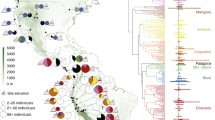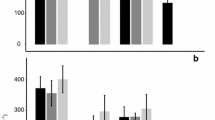Abstract
Resting and maximal mass-specific metabolic rates scale inversely with body mass. Small hummingbirds achieve the highest known mass-specific metabolic rates among vertebrate homeotherms. Maximal capacities for O2 and substrate delivery to muscle mitochondria, as well as mitochondrial oxidative capacities in these animals may be at the upper limits of what are structurally and functionally possible given the constraints inherent in vertebrate design. Such constraints on the evolutionary design of functional capacities may play an important role in determining the lower limits to vertebrate homeotherm size and the upper limits to mass-specific metabolic rate.
Similar content being viewed by others
References
Alp, P. R., Newsholme, E. A., and Zammit, V. A., Activities of citrate synthase and NAD+-linked isocitrate dehydrogenase in muscle from vertebrates and invertebrates. Biochem. J.154 (1976) 689–700.
Bartholomew, G. A., and Lighton, J. R. B., Oxygen consumption during hover-feeding in free-ranging Anna hummingbirds. J. exp. Biol.123 (1986) 191–199.
Berger, M., Sauerstoffverbrauch von Kolibris (Colibri coruscans undC. thalassinus) beim Horizontalflug, in: BIONA Report 3, pp. 307–314. Ed. W. Nachtigall. Akad. Wiss. Mainz G. Fischer, Stuttgart and New York 1985.
Carpenter, F. L., Paton, D. C., and Hixon, M. A., Weight gain and adjustment of feeding territory size in migrant hummingbirds. Proc. natl Acad. Sci. USA80 (1983) 7259–7263.
Casey, T. M., and Ellington, C. P., Energetics of insect flight, in: Energy Transformations in Cells and Organisms, pp. 200–210. Eds W. Wieser and E. Gnaiger. Georg Thieme Verlag, Stuttgart and New York 1990.
Conley, K. E., Christian, K. A., Hoppeler, H., and Weibel, E. R., Capillary and mitochondrial unit in muscles of a large lizard. Am. J Physiol.256 (1989) R982-R989.
Davis, R. A., and Fraenkel, G., The oxygen consumption of flies during flight. J. exp. Biol.17 (1940) 402–407.
Diamond, J. M., Karasov, W. H., Phan, D., and Carpenter, F. L., Digestive physiology is a determinant of foraging bout frequency in hummingbirds. Nature320 (1986) 62–63.
Drummond, G. I., Microenvironment and enzyme function: control of energy metabolism during muscle work. Am. Zool.11 (1971) 83–97.
Dubach, M., Quantitative analysis of the respiratory system of the house sparrow, budgerigar and violet-eared hummingbird. Respir. Physiol.46 (1981) 43–60.
Emmett, B., and Hochachka, P. W., Scaling of oxidative and glycolytic enzymes in mammals. Respir. Physiol.45 (1981) 261–272.
Epting, R. J., Functional dependence of the power for hovering on wing disc loading in hummingbirds. Physiol. Zool.53 (1980) 347–352.
Greenewalt, C. H., Hummingbirds. Doubleday, New York 1960.
Grunyer, I., and George, J. C., Some observations on the ultrastructure of the hummingbird pectoral muscles. Can. J. Zool.47 (1969) 771–774.
Hainsworth, F. R., Energy regulation in hummingbirds. Am. Sci.69 (1981) 420–429.
Hartman, F. A., Locomotor mechanisms of birds. Smithson. Inst. misc. Collect.143 (1961) 1–91.
Hochachka, P. W., Fuels and pathways as designed systems for muscle work. J. exp. Biol.115 (1985) 149–164.
Hochachka, P. W., Limits: How fast and how slow muscle metabolism can go, in: Advances in Myochemistry vol. 1, pp. 3–12. Ed. G. Benzi. John Libbey, Eurotext 1987.
Hochachka, P. W., Emmett, B., and Suarez, R. K., Limits and constraints in the scaling of oxidative and glycolytic enzymes in homeotherms. Can. J. Zool.66 (1988) 1128–1138.
Hochachka, P. W., Neely, J. R., and Driedzic, W. R., Integration of lipid utilization with Krebs cycle activity in muscle. Fedn Proc.36 (1977) 2009–2014.
Hochachka, P. W., and Somero, G. N., Strategies of Biochemical Adaptation. Saunders, Philadelphia 1973.
Hoppeler, H., and Lindstedt, S. L., Malleability of skeletal muscle in overcoming limitations: structural elements. J. exp. Biol.115 (1985) 355–364.
Johansen, K., The world as a laboratory: physiological insights from Nature's experiments, in: Advances in Physiological Research, pp. 377–396. Eds H. McLennan, J. R. Ledsome, C. H. S. McIntosh and D. R. Jones. Plenum Press, New York 1987.
Johansen, K., Berger, M., Bicudo, J. E. P. W., Ruschi, A., and De Almeida, P. J., Respiratory properties of blood and myoglobin in hummingbirds. Physiol. Zool.60 (1987) 269–278.
Karasov, W. H., Phan, D., Diamond, J. M., and Carpenter, F. L., Food passage and intestinal nutrient absorption in hummingbirds. Auk103 (1986) 453–464.
Krebs, J. R., and Harvey, P. H., Busy doing nothing — efficiently. Nature320 (1986) 18–19.
Lasiewski, R. C., The energetics of migrating hummingbirds. Condor64 (1962) 324.
Lasiewski, R. C., Oxygen consumption of torpid, resting, active, and flying hummingbirds. Physiol. Zool.36 (1963) 122–140.
Lasiewski, R. C., Body temperatures, heart and breathing rate, and evaporative water loss in hummingbirds. Physiol. Zool.37 (1964) 212–223.
Lasiewski, R. C., Galey, F. R., and Vasquez, C., Morphology and physiology of the pectoral muscles of hummingbirds. Nature206 (1965) 404–405.
Mainwood, G. W., and Rakusan, K., A model for intracellular energy transport. Can. J. Physiol. Pharmac.60 (1982) 98–102.
Mansour, T. E., Wakid, N., and Sprouse, H. M., Studies on heart phosphofructokinase. Purification, crystallization, and properties of sheep heart phosphofructokinase. J. biol. Chem.241 (1966) 1512–1521.
Martinez del Rio, C., Dietary, phylogenetic, and ecological correlates of intestinal sucrase and maltase activity in birds. Physiol. Zool.63 (1990) 987–1011.
Newsholme, E. A., and Crabtree, B., Maximum catalytic activity of some key enzymes in provision of physiologically useful information about metabolic fluxes. J. exp. Zool.239 (1986) 159–167.
Odum, E. P., Connell, C. E., and Stoddard, H. L., Flight energy and estimated flight ranges of some migratory birds. Auk78 (1961) 515–527.
Pennycuick, C. J., and Rezende, M. A., The specific power output of aerobic muscle, related to the power density of mitochondria. J. exp. Biol.108 (1984) 377–392.
Powers, D. R., and Nagy, K. A., Field metabolic rate and food consumption by free-living Anna's hummingbirds (Calypte anna). Physiol. Zool.61 (1988) 500–506.
Ramadoss, C. S., Luby, L. J., and Uyeda, K., Affinity chromatography of phosphofructokinase. Archs Biochem. Biophys.175 (1976) 487–494.
Schmidt-Nielsen, K., Scaling. Why is Animal Size So Important? Cambridge Univ. Press, Cambridge 1984.
Schwerzmann, K., Hoppeler, H., Kayar, S. R., and Weibel, E. R., Oxidative capacity of muscle and mitochondria: correlation of physiological biochemical and morphometric characteristics. Proc. natl Acad. Sci. USA86 (1989) 1583–1587.
Smith, D. S., The structure of flight muscle sarcosomes in the blowflyCalliphora erythrocephala (Diptera). J. Cell Biol.19 (1963) 114–138.
Srere, P. A., Organisation of proteins within the mitochondrion, in: Organized Multienzyme Systems. Catalytic Properties, pp. 1–61. Ed. G. Rickey Welch, Academic Press, New York and London 1985.
Suarez, R. K., Oxygen and VO2max: are muscle mitochondria created equal? Proc. 7th Int. Hypoxia Symp. (1992) in press.
Suarez, R. K., Brown, G. S. and Hochachka, P. W., Metabolic sources of energy for hummingbird flight. Am. J. Physiol.251 (1986) R537-R542.
Suarez, R. K., Brownsey, R. W., Vogl, W., Brown, G. S. and Hochachka, P. W., Biosynthetic capacity of hummingbird liver. Am. J. Physiol.255 (1988) R699-R702.
Suarez, R. K., Lighton, J. R. B., Brown, G. S., and Mathieu-Costello, O., Mitochondrial respiration in hummingbird flight muscles. Proc. natl Acad. Sci. USA88 (1991) 4870–4873.
Suarez, R. K., Lighton, J. R. B., Moyes, C. D., Brown, G. S., Gass, C. L., and Hochachka, P. W., Fuel selection in hummingbirds: ecological implications of metabolic biochemistry. Proc. Natl Acad. Sci. USA87 (1990) 9207–9210.
Taylor, C. R., Structural and functional limits to oxidative metabolism: insights from scaling. A. Rev. Physiol.49 (1987) 135–146.
Taylor, C. R., Maloiy, G. M. O., Weibel, E. R., Langman, V. A., Kamai, J. M. Z., Seeherman, H. J., and Heglund, N. C., Design of the mammalian respiratory system. III. Scaling maximum aerobic capacity to body mass: wild and domestic animals. Respir. Physiol.44 (1980) 25–37.
Weibel, E. R., Design and performance of muscular systems: an overview. J. exp. Biol.115 (1985) 405–412.
Weis-Fogh, T., Energetics of hovering flight in hummingbirds and inDrosophila. J. exp. Biol.56 (1972) 79–104.
Woeltje, K. F., Kuwajima, M., Foster, D. W., and McGarry, J. D., Characterization of the mitochondrial carnitine palmitoyltransferase enzyme system. II. Use of detergents and antibodies. J. biol. Chem.262 (1987) 9822–9827.
Author information
Authors and Affiliations
Rights and permissions
About this article
Cite this article
Suarez, R.K. Hummingbird flight: Sustaining the highest mass-specific metabolic rates among vertebrates. Experientia 48, 565–570 (1992). https://doi.org/10.1007/BF01920240
Published:
Issue Date:
DOI: https://doi.org/10.1007/BF01920240




